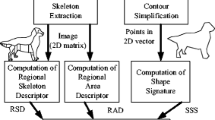Abstract
The shape feature of an object represents the geometrical information which plays an important role in the image understanding and image retrieval. How to get an excellent shape feature that has rotation, scaling and translation (RST) invariance is a problem in this field. This paper proposed a novel local extreme learning machine (LELM) classification algorithm to extract the shape features. LELM finds nearest neighbors of the testing set from the original training set and trains a local classification model. The shape feature is represented by an analytic decision function with a radial basis function (RBF) kernel obtained by LELM. Our method has the following advantages: (1) LELM not only keeps the local structure of the samples, but also solves the imbalance problem between variance and bias. (2) Features obtained by the RBF kernel are RST invariant. (3) LELM is more robust against the noise and fragmentation compared to other methods. We also demonstrate the performance of the proposed method in image retrieval.










Similar content being viewed by others
References
Gonzalez Rafael C, Woods Richard E (2010) Digital image processing, 3rd edn. Electronic Industry Press, Beijing
ISO/IEC JTC1/SC29/WG11N6828, MPEG-7 Overview (version 10)
Zhang D, Lu G (2004) Review of shape representation and description techniques. Pattern Recognit 37(1):1–19
Mokhtarian F (1995) Silhouette-based isolated object recognition through curvature scale space. IEEE Trans Pattern Anal Mach Intell 17(5):539–544
Mokhtarian F, Bober M (2011) Curvature scale space representation: theory, applications, and MPEG-7 standardization. Springer Publishing Company, Incorporated
Abbasi S, Mokhtarian F, Kittler J (1999) Curvature scale space image in shape similarity retrieval. Multimed Syst 7(6):467–476
Lien JM, Amato NM (2008) Approximate convex decomposition of polyhedra and its applications. Comput Aided Geom Des 25(7):503–522
Liu H, Liu W, Latecki LJ (2010) Convex shape decomposition[C]//Computer Vision and Pattern Recognition (CVPR), In: 2010 IEEE conference on IEEE, pp 97–104
Adamek T, O’Connor NE (2004) A multiscale representation method for nonrigid shapes with a single closed contour. IEEE Trans Circuits Syst Video Technol 14(5):742–753
Ling H, Jacobs DW (2007) Shape classification using the inner-distance. IEEE Trans Pattern Anal Mach Intell 29(2):286–299
Hua J, Lai Z, Dong M, Gu X, Qin H (2008) Geodesic distance-weighted shape vector image diffusion. IEEE Trans Vis Comput Graph 14(6):1643–1650
Gorelick L, Galun M, Sharon E et al (2006) Shape representation and classification using the poisson equation. IEEE Trans Pattern Anal Mach Intell 28(12):1991–2005
Cohen-Steiner D, Alliez P, Desbrun M (2004, August) Variational shape approximation. In ACM Transactions on Graphics (TOG). ACM, vol 23, No. 3, pp 905–914
Osher S, Sethian JA (1988) Fronts propagating with curvature-dependent speed: algorithms based on Hamilton–Jacobi formulations. J Comput Phys 79(1):12–49
Malladi R, Sethian JA, Vemuri BC (1995) Shape modeling with front propagation: a level set approach. IEEE Trans Pattern Anal Mach Intell 17(2):158–175
Belongie S, Malik J, Puzicha J (2002) Shape matching and object recognition using shape contexts. IEEE Trans Pattern Anal Mach Intell 24(4):509–522
Mori G, Belongie S, Malik J (2005) Efficient shape matching using shape contexts. IEEE Trans Pattern Anal Mach Intell 27(11):1832–1837
Van Nguyen H, Porikli F (2013) Support vector shape: a classifier-based shape representation. IEEE Trans Pattern Anal Mach Intell 35(4):970–982
Cortes C, Vapnik V (1995) Support-vector networks. Mach Learn 20(3):273–297
Suykens JA, Vandewalle J (1999) Least squares support vector machine classifiers. Neural Process Lett 9(3):293–300
Huang GB, Zhu QY, Siew CK (2006) Extreme learning machine: theory and applications. Neurocomputing 70(1):489–501
Zong W, Huang GB (2011) Face recognition based on extreme learning machine. Neurocomputing 74(16):2541–2551
Li MB, Huang GB, Saratchandran P, Sundararajan N (2005) Fully complex extreme learning machine. Neurocomputing 68:306–314
Huang GB, Ding X, Zhou H (2010) Optimization method based extreme learning machine for classification. Neurocomputing 74(1):155–163
Bai Z, Huang GB, Wang D et al (2014) Sparse extreme learning machine for classification. IEEE Trans Cybern 44(10):1858–1870
Huang GB, Zhou H, Ding X, Zhang R (2012) Extreme learning machine for regression and multiclass classification. IEEE Trans Syst Man Cybern Part B Cybern 42(2):513–529
Huang GB (2014) An insight into extreme learning machines: random neurons, random features and kernels. Cogn Comput 6(3):376–390
Dalal N, Triggs B (2005, June) Histograms of oriented gradients for human detection. In Computer Vision and Pattern Recognition, 2005. CVPR 2005. IEEE Computer Society Conference on IEEE, vol 1, pp. 886–893
Cover TM (1968) Estimation by the nearest neighbor rule. IEEE Trans Inf Theory 14(1):50–55
Sharvit D, Chan J, Tek H, Kimia BB (1998, June) Symmetry-based indexing of image databases. In Content-Based Access of Image and Video Libraries, 1998. In: Proceedings. IEEE workshop on IEEE, pp 56–62
Sebastian TB, Klein PN, Kimia BB (2004) Recognition of shapes by editing their shock graphs. IEEE Trans Pattern Anal Mach Intell 26(5):550–571
Acknowledgments
This research is supported by National Natural Science Foundation of China Nos. 61173163, 51105052, 61370200.
Author information
Authors and Affiliations
Corresponding author
Rights and permissions
About this article
Cite this article
Zhang, J., Feng, L. & Wu, B. Local extreme learning machine: local classification model for shape feature extraction. Neural Comput & Applic 27, 2095–2105 (2016). https://doi.org/10.1007/s00521-015-2008-7
Received:
Accepted:
Published:
Issue Date:
DOI: https://doi.org/10.1007/s00521-015-2008-7




